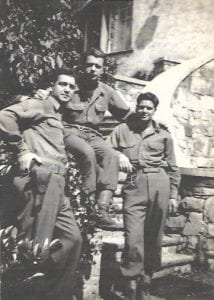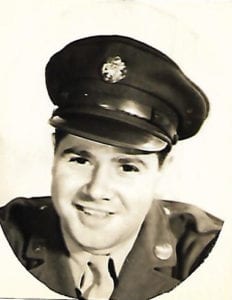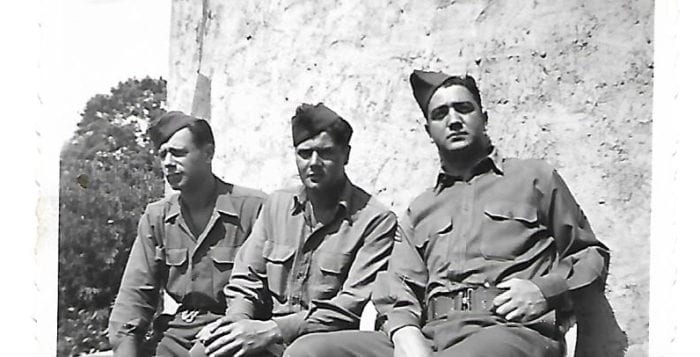WWII vet and Rocky Point resident remembered for community efforts
By Rich Acritelli
A longtime resident of Rocky Point and distinguished World War II veteran, Dominick T. LoSquadro died Aug. 2. He was 97.
Through hardship and trial, this World War II veteran was the epitome of what is often considered the Greatest Generation. He was an active member of the VFW Post 6249 Rocky Point, and the veterans organization lost a dynamic and key member of its organization this month, one that always wanted to help other military service members and community residents.

LoSquadro’s story began as a poor Brooklyn kid — born July 28, 1922. He was the youngest of seven children with four brothers and two sisters. Growing up his family had no comforts at home. They survived due to the hard work of their father, who delivered blocks of ice, and their mother who managed a grocery store. Their home had no heat or hot water and when the would-be Rocky Point resident was a child, his brothers paid him a nickel to warm the toilet seat for their use. It was a common practice for this family to stay near the kitchen, where they felt some warmth from the cooking stove. Dominick did not take a hot shower until he was drafted into the Army as a young man during World War II.
The boys grew up with Italian-speaking parents, but together they only spoke a few words of the language, and their mom spoke little English. There were only a couple of Italian words that were utilized in order to communicate with each other. Years later, when LoSquadro was stationed in Germany, he understood and spoke German more than he could Italian.
As a kid who grew up in the streets of Brooklyn, LoSquadro collected rags and sticks which he sold to a local junk vendor. He used the pennies and nickels he earned for movie tickets. He also worked with his father to deliver ice to various parts of the city. As a child his poor eyesight led to equally poor grades, and his teachers did not realize that he had a difficult time reading the board and they continually moved him to the back of the classroom. They believed that he was a challenged student that was unable to keep up with their instructions and, for many years, LoSquadro never fully realized his educational potential.
During his teenage years, family and friends remembered he always had a brilliant smile and a full head of hair, making him a favorite of local ladies. He was a talented ballroom dancer who immensely enjoyed listening to popular big band music in New York City. Before the war, LoSquadro enrolled into an automotive school where he earned a degree so he could be a mechanic. He flourished in this environment, and he would take his expertise in fixing, driving and directing heavy machinery in his military and civilian occupations.
For the late Rocky Point resident’s generation, it was a trying time to be a young adult after the Japanese bombed Pearl Harbor Dec. 7, 1941. The United States quickly entered the war effort to fight the Japanese in the Pacific and the Germans in North Africa and Europe. Right away, the five “LoSquadro brothers” entered the military to do their part. Like that of his three older brothers, Dominick was drafted into the Army Dec. 29, 1942, where he applied his civilian trade as a mechanic in the service. His earliest military time began at Camp Upton Army base in Yaphank, where he entered his basic training with a serious fever that quickly became an ear infection. LoSquadro was stationed at several military bases in Florida, Georgia, Oklahoma and South Carolina, but as these units were shipped overseas, he was not sent with them due to his medical condition. The Army warned that if he was attacked with chemical or biological weapons that it could prove to be terribly fatal due to his ailments.
Despite being held back, it was his goal to be ordered overseas to be near his family members and friends that were already fighting against the Germans and Japanese. The Army eventually looked past his medical record and shipped him to Liverpool, England, where he was quickly sent to France. LoSquadro was vital in keeping the trucks, jeeps and tanks moving against the strength of the Germans, as they were pushed back to their own border. He also conducted backbreaking labor, as he helped reconfigure air strips after they were bombed and damaged by the German Luftwaffe.
Like that of other American families, the LoSquadro boys were all in harm’s way trying to fight against the fascist regime. His brother, Frank, was with the second wave of the June 6, 1944, Normandy landings at Omaha Beach. That December, Frank was a medic that survived the Battle of the Bulge, where just about his entire unit was killed by the Germans. At one point, he acted as if he was dead for three days to avoid being shot or captured by the enemy. Later, the army wanted Frank to re-enlist, but he had witnessed terrible accounts during the war and he wanted to go home. LoSquadro’s brother rarely spoke about his traumatic experiences.
During the height of the war, the brothers were determined to meet up with each other. Dominick worked on the military trucks that operated at the air fields, where they loaded and delivered war supplies to the soldiers in the field. He was in closer contact with his brother Frank who was stationed near the railroad lines at the front. They both decided to search for their brother Nicholas, who served with the Office of Strategic Services (later renamed the Central Intelligence Agency during the Cold War). He helped collect and analyze intelligence from enemy double agents, the resistance, captured prisoners of war and more.
Both Dominick and Frank hitchhiked on the French roads as they were looking for Nicholas. They were pleasantly surprised, as it was Nicholas who discovered them as he drove down a road in his jeep. These two brothers, both grunts, saw a much different face of the military from Nicholas who was an officer, as he was not often in the field and he lived in homes that had servants to clean his clothing and cook meals. They were overjoyed to be briefly together during the course of the war, where they were alive, united and fighting for their nation.

At the very end of World War II, as the U.S. dealt with the growing power of the Soviet Union in Europe and the end of the fighting against the Japanese in Asia, the LoSquadros were formerly recognized for their service. About a week before the Japanese surrendered on Sept. 2, 1945, their mother received a letter from Secretary of War Henry L. Stimson. It genuinely stated, “For my part, I should like to assure you of the deep appreciation of the nation which has accepted their service with gratitude and a strong sense of responsibility.” Stimson was one of the most powerful leaders in the nation to oppose Germany and Japan, and he evidently respected the role that the entire LoSquadro family played to help defeat the Axis powers.
As a seasoned veteran that spent over three years in the military, LoSquadro finally returned home to New York City where he was employed as a diaper and furniture delivery man. In the late 1940s, he brought these items to famous musicians like that of Jimmy and Tommy Dorsey and to the actress Kitty Carlisle. Later in life, LoSquadro had poor knees and it was attributed to running up the stairs of high-rise buildings where he made these deliveries. It was not until the mid-1950s that LoSquadro was motivated to earn a city job. Once he was examined for his eyes, it turned out that he was an able test taker and he performed well on exams, and he was later employed as a bus driver.
After the war, LoSquadro again flourished as a dancer, and he always received interest from the ladies that had liked his ballroom skills and looks. He spent many nights at the Roseland Dance Club in Manhattan, near the Ed Sullivan Theater. He was friends with all of the bouncers, perfected his craft of dancing and met his wife at this establishment. Once he was married, LoSquadro raised a family of five children, including one son and four daughters at homes in Corona and Elmhurst. While he worked long hours, he was known for his creativity as a handyman who could repair practically anything. He drove many hours of overtime to support his large family on one salary. The World War II vet was known for spending many hours studying for the Metropolitan Transit Authority exams which enabled him to be promoted as a foreman and later a general superintendent. As when in the Army, LoSquadro also faced resentment for being an Italian American as he began to get promoted within higher city positions at the MTA.
He would eventually become responsible for operating large bus garages in Queens Village and in Flushing near the present home of the New York Mets at Citi Field. For many years, he handled numerous responsibilities with the drivers, investigated bus accidents within his district, petitioned for additional funds and made sure that his garages followed MTA regulations. He was always known for utilizing common sense and fairness with a staff of over 500 workers. He would grow to be respected for helping to provide transportation services utilized by millions of people within the city.
During his spare time, local family and friends counted on LoSquadro to repair umbrellas, bicycles, doors, windows and anything that needed some TLC. His children widely believed that if it was broke, that “daddy could fix it.” As a young kid that endured poverty, LoSquadro utilized his ingenuity to recycle products and save money. Later in life, he always enjoyed having nice clothing and cars, but he never forgot the lessons that poverty teaches. It is said in his prime that he had an unbelievable amount of stamina, allowing him to work all day and tinker in his basement for hours where he became a self-taught carpenter.
In the early 1980s, Dominick began living with a longtime companion, where they renovated a bungalow in Rocky Point. For many years, he was a devoted member to Post 6249 Rocky Point Veterans of Foreign Wars, helping to provide aid to vital military and civilian causes. Armed with a big smile and can-do attitude, he was one of the founding members of the post’s annual Wounded Warrior Golf Outing, which raised over $200,000 to help local veterans severely hurt from the War on Terror. LoSquadro knew all of the players, he handed out T-shirts to the golfers, counted raffle ticket money and spoke to all of the wounded armed forces members who were recognized by the organization. Even in his 90s, LoSquadro led an energetic life where he was overjoyed to participate in the many successful activities of Post 6249.
Several years ago, this decorated member of the Greatest Generation finally received his diploma from Rocky Point High School, with students, parents and staff giving him a rousing round of applause. At his wake, Post 6249 Commander Joe Cognitore and post members lined up at the funeral home to pay the ultimate respect to this noted veteran. With tears in his eyes, Cognitore expressed the final goodbyes to one of his best friends. Both of these men were inseparable, as they lobbied government leaders for local and national veteran’s affairs, attended the local summer concert series, marched and presented the colors at local schools during Veterans Day ceremonies and they often went to local restaurants and diners for lunch.
As a member of this post that had worked closely with LoSquadro, it is my firmest belief that if you were friends with Dominick T. LoSquadro, his acquaintance surely made you into a finer person. Thank you to the unyielding efforts of this veteran to ensure the defense of the United States and his many wonderful contributions as a citizen, all who felt his presence during his time on Earth.
Rich Acritelli is a social studies teacher at Rocky Point High School and an adjunct professor of American history at Suffolk County Community College.







